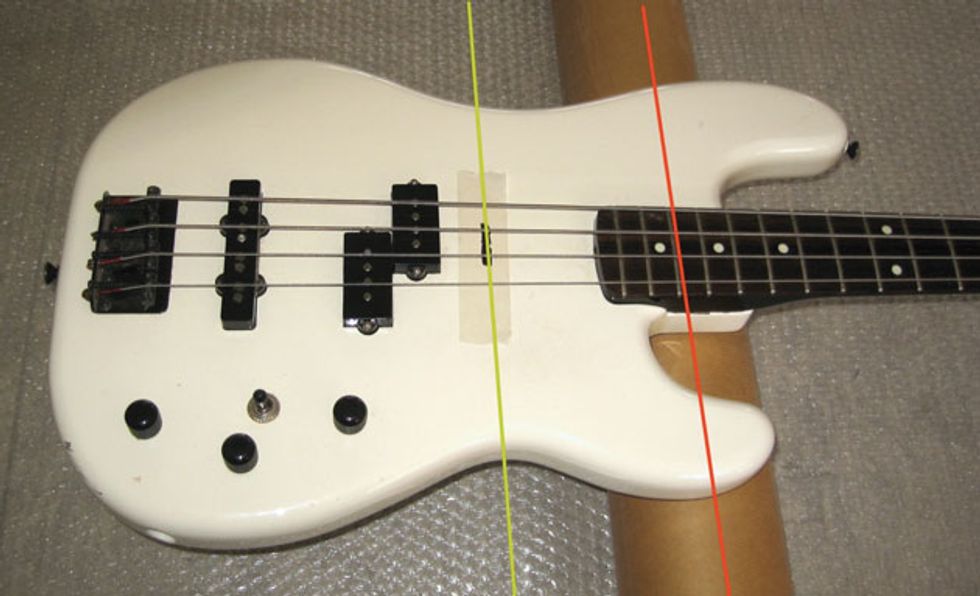Most basses are heavy and unbalanced. Should you be concerned about how this affects your body?
Photo courtesy of basslab.de
Remember when your parents told you to stand straight and pull your shoulders back? Totally annoying, right? But it turns out to be good advice, even if most parents aren’t fully aware of why it is so important. Bad posture creates back problems—one of the main causes of disablement in the Western world. Roughly 60 percent of all adults complain about regular back pain, but we can expect these numbers to be even higher among bass players, given that we shoulder heavy instruments with unequal weight distribution during long rehearsals or even eight-hour wedding gigs.
While we can rarely influence the duration of our gigs and rehearsals, such other factors as weight and it’s distribution on our shoulders should be within our control. There are high-quality, lightweight basses available, but sometimes you need to stick to a certain tool for the task, whether that’s for sonic reasons, due to finances, or just a matter of image. So when weight reduction isn’t an option, next up is weight distribution.
We’ve all read reviews that laud well-balanced basses or critique neck divers, but there’s more to it. When an instrument hangs on a strap, we can classify its three states as neck heavy, neck horizontal, or neck angled upward (as with classical guitar). At first, the horizontal and upward positions might both be considered “well balanced,” but there’s one thing that makes the horizontal position turn into a neck dive.
Do you recall the kid’s game that tests how long you can stretch your arms out from your body and hold them horizontal? If your first thought is close to an hour, think again (or better yet, give it a try). You won’t last as long as most gigs, which explains why we end up resting our arm on the neck from time to time when working the fretboard. This simple act turns a neck-horizontal bass into a diver. To counteract that tendency, you’ll naturally press your other arm down against the contour or edge of the body, and this can easily double the overall weight resting on your shoulder.
Some will argue that you can avoid most of these shoulder and back problems by getting a good strap. A wide, stiff strap with a soft inner side will certainly help spread the pressure and not cut into your shoulder or collarbone. This might be sufficient for those with light back pain, but other than that, it will in no way affect the unequal conditions for each shoulder. It’s this disparity that plagues some bassists with severe back pain—especially long-time players.
One of the oldest approaches to reducing this disparity is to wear a secondary strap that runs over the other shoulder. Such double-strap systems are similar to those used for carrying saxophones, marching drums, or tubas. These systems are designed to be fairly symmetrical around the instrument’s center of gravity, which is clearly not the case with a bass.
If you want to know whether a double-strap design could help with your bass, the first thing you need to do is determine its center of gravity for the vertical axis. Let’s make a game out of this: Before you go any further, mark the position where you think the center of gravity is. Most players are surprised how far off they really are.
To find the center of gravity, simply balance the bass on any chair armrest or other solid edge, as in Photo 1. The red line shows the center of gravity on a Fender Jazz bass, while the green line in front of the neck pickup indicates where the owner thought it would be. The distance from the center of gravity to each strap pin offers a clue to how much of the instrument’s weight would end up on each of your shoulders in a double-strap design. Just as it is here, on most basses the outcome will be somewhat unbalanced.
This is a good opportunity to reiterate that headless instruments have a far better weight distribution and balance than conventional basses with their headstocks and tuning hardware. In case you choose the latter system based on its visual appearance, remember this bit of folk wisdom: “One must suffer to be beautiful.” But instead of suffering, next month we’ll investigate some other more-or-less innovative solutions to relieve shoulder and back pain.


